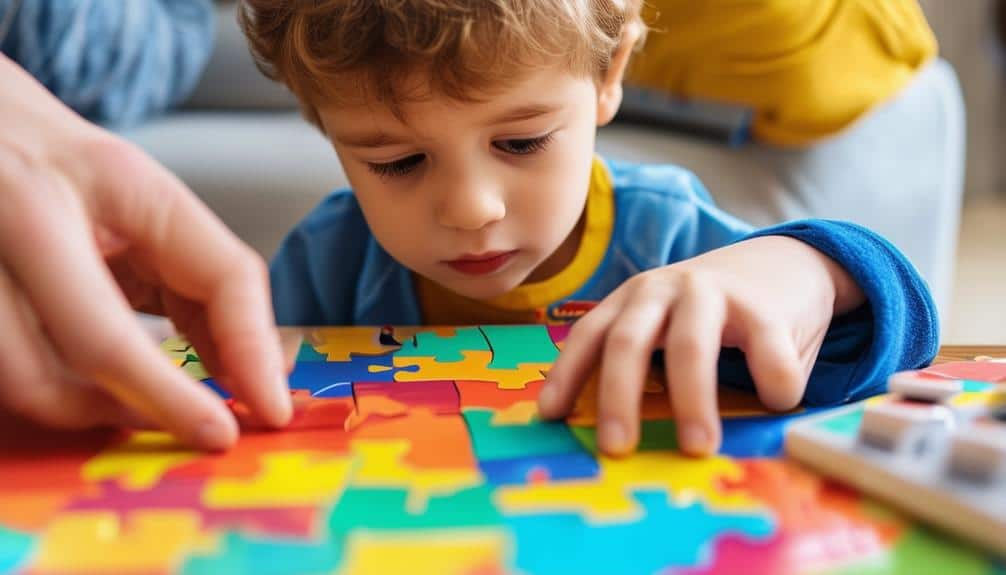Helping your autistic child gain independence may feel overwhelming, but it’s possible with the right approach. Autism independence starts with understanding your child’s needs and strengths. You can significantly impact their communication skills and encourage independent activities that match their interests.
By tailoring these nine strategies to fit your child’s abilities and preferences, you empower them to interact confidently with the world. Autism independence isn’t about the child; it’s about how you, as a parent, support and guide them toward self-sufficiency, fostering growth every step of the way.
Key Takeaways
- Implement robust communication strategies, including visual aids and alternative communication methods like AAC.
- Foster financial insight and vocational abilities through real-life settings and inclusion in the child.
- Teach community safety practices such as understanding safety signs and using public transportation.
- Encourage participation in independent leisure activities, translating special interests into age-appropriate pursuits.
- Customize the environment and implement sensory support strategies, like sensory diets and calming scents, to enhance focus and independence.
Understanding Autism and Independence
To fully appreciate the concept of independence in children with autism, it is essential to understand the unique challenges these individuals encounter in accomplishing daily tasks. Autism is a spectrum disorder, meaning that it affects individuals differently and to varying degrees. Accordingly, the level of independence that children with autism can achieve will vary based on their distinct strengths, needs, and abilities.
Building independence in children with autism requires tailored strategies that consider their communication, sensory, and cognitive differences. While some children may excel in certain areas, they may struggle in others, making it crucial to adopt a personalized approach when fostering independence.
Recognizing the significance of fostering independence in autistic children can increase self-confidence and success. By focusing on their capabilities rather than their limitations, we can empower them to navigate daily tasks and changes more effectively. Providing consistent support and guidance in developing these independence skills is fundamental to this process. When we encourage children with autism to build independence, we equip them with the tools to face life’s challenges with confidence.
Improving Communication and Routine
For children with autism, developing strong communication skills and establishing familiar routines can significantly enhance their independence. Implementing alternative communication methods and visual aids can create a safer, more predictable environment, reducing anxiety and promoting self-regulation. Moreover, introducing practical tasks within daily routines can foster a sense of responsibility, aiding the progress towards a more autonomous lifestyle.
Strengthening Alternative Communication
Harnessing the power of Different Communication methods, such as Augmentative and Alternative Communication (AAC), can dramatically enhance communication skills and independence in children with autism, paving the way for better comprehension and execution of daily routines. AAC allows children to express their needs, desires, and thoughts clearly, decreasing frustration and increasing self-confidence.
Visual supports, like a Visual Schedule, are another pivotal aspect of Alternative Communication. They provide a structured and predictable environment, which can reduce anxiety and improve task accomplishment.
| Communication Method | Benefits |
|---|---|
| AAC | Enhances expression, reduces frustration, improves self-confidence |
| Visual Schedule | Increases structure predictability, reduces anxiety and improves task completion. |
Teaching children these supports can lead to better communication, understanding, and independence in various tasks. Consistent use of visual supports and AAC can empower children to navigate daily routines with increased ease and self-assuredness. It’s a journey of progress, not perfection; the results can be transformative. Let’s continue to explore, understand, and apply these strategies, helping children with autism achieve greater independence.
Visual Aids for Transitions
Moving through the maze of daily changes and routines can often pose a challenge for children with autism. Still, strategically using visual aids such as picture schedules and timers can significantly enhance their understanding and independence.
Visual aids provide a tangible and predictable structure, aiding in the comprehension of changes and reducing anxiety. They serve as a visual roadmap, guiding children through their day with a clear, concrete representation of what will come. This reduces the uncertainty around changes and helps foster a sense of control and self-reliance.
Here are some benefits of visual aids for children with autism:
- They enhance communication skills by providing a clear and consistent visual representation of activities and changes.
- They reduce anxiety during changes by setting clear expectations.
- The research underscores their efficacy, particularly in improving understanding schedules and expectations.
- They can be customized to meet the child’s needs, promoting independence and reducing meltdowns.
Consistent implementation of visual aids across various settings can lead to increased independence and smoother changes for children with autism. This powerful tool can significantly enhance their daily life, promoting self-reliance and higher comfort and security.
Encouraging Self-Care Skills
Building upon the foundation of visual aids, another critical aspect of promoting independence in children with autism is enhancing their self-care skills, such as brushing their teeth and combing their hair. It is essential to understand that these tasks, seemingly simple for many, can often be challenging for a child with autism. Thus, patience, empathy, and consistent guidance are vital to teaching these skills.
Strengthening communication skills can significantly aid this process. Utilizing alternative/augmentative communication (AAC) and visual supports can facilitate a better understanding of these tasks and help children express themselves if they are experiencing difficulty. This approach fosters a supportive environment where children feel safe to express themselves, promoting their autonomy.
Creating a visual schedule can be beneficial in establishing routines and shifts, making daily activities smoother. This tangible reference can reduce anxiety and provide a clear structure, enhancing the child’s confidence in performing self-care tasks independently.
We should also teach children to request a break when feeling overwhelmed. This ability is a self-care skill and a valuable tool for self-advocacy, demonstrating that their feelings and needs are valid and recognized. In doing so, we nurture their growth toward independence in a compassionate and empowering manner.
Inculcating Money and Vocational Skills

Cultivating financial insight and vocational abilities in children with autism from an early age is imperative in fostering their independence and preparing them for future employment opportunities. By integrating vocational skills and money management into their everyday activities, we can set the stage for their future self-sufficiency.
In a practical sense, this involves:
- They are incorporating money management skills in daily activities, such as shopping or budgeting for their personal needs.
- Introducing vocational skills training early to prepare the child for potential employment sectors, such as food preparation, gardening, or office work.
- Using real-life settings to teach about completing transactions and handling money reinforces the children’s understanding of money’s value and usage.
- The child’s personalized education plan (IEP) should include money and vocational skills development goals to align educational activities with the child’s independence objectives.
Tools like My Job Chart can also be beneficial, helping children with autism learn about tasks, time management, and responsibility. By doing so, we are not just teaching them a skill but also instilling a sense of purpose and accomplishment, essential for their confidence and self-esteem.
Teaching Community Safety Practices
Fostering independence in children with autism involves more than just instilling essential life skills—it also requires teaching them safety practices for maneuvering their community. Key to this is learning to identify safety signs, understanding the use of public transportation, and grasping the essentials of travel training. These children can move freely and safely by mastering these components, enhancing their self-reliance and ability to participate in the wider world.
Identifying Safety Signs
Teaching autistic children to identify safety markers and signs within their community is essential to promoting independence and safety. This process allows them to navigate their surroundings more confidently and with less apprehension. Visual supports, such as flashcards and pictorial guides, can assist in this endeavor, enhancing their recognition and understanding of essential safety signs.
Teaching children with autism to identify safety signs is a multi-step process that involves:
- Using visual supports, we introduce the child to different safety signs in a controlled environment.
- I practice recognizing these signs through role-play, interactive games, and simulated scenarios.
- Gradually expose the child to actual situations where they can apply their knowledge.
- They are constantly reinforcing and revising these safety signs to ensure that the knowledge remains fresh in their minds.
In addition, providing children with an ID card containing essential information can prove helpful in emergencies. Tools like the GET Going pocket guide offer invaluable resources to teach children about community safety practices. The aim is to empower these children, fostering independence while guaranteeing their safety. This is a critical part of their journey towards self-reliance and autonomy.
Utilizing Public Transportation
To further enhance their independence and safety in the community, it is vital to teach children with autism how to effectively and safely navigate public transportation. Familiarizing them with bus routes, schedules, and safety guidelines promotes independent travel and guarantees they are equipped to handle emergencies.
Active involvement in learning the public transportation system is essential. Let them identify safety markers and signs when waiting for or using public transportation. This hands-on approach builds their confidence and competence, fostering independence.
Practicing using public transportation together offers a safe environment in which to acquire these skills. It allows them to understand the practical application of what they learn and will enable them to make and rectify mistakes under your guidance.
Consider providing your child with an ID card containing emergency contact information. This is a simple yet effective safety measure when they use public transportation independently.
While the process requires patience and dedication, instilling these skills in children with autism can significantly enhance their independence. The knowledge to navigate public transportation is a step towards their self-reliance and an integral part of their community safety practices.
Understanding Travel Training
Understanding the concept of travel training is fundamental to promoting safety and independence in children with autism. It equips them with essential skills such as identifying safety markers, maneuvering public transportation, and practicing pedestrian safety. This training demystifies public transit and helps autistic children become more confident and self-sufficient members of their communities.
Travel training encompasses a range of skills and practices, including:
- Familiarization with public transportation routes and schedules instills confidence and independence in navigating their community.
- We teach appropriate travel etiquette, foster respectful interactions with others, and reduce anxiety during transit.
- Using an ID card provides extra safety and reassurance for the child and their caregivers in emergencies.
- It utilizes resources such as the GET Going pocket guide, a valuable tool that offers safety tips and strategies for community safety practices.
Promoting Independent Leisure Activities

Encouragement to engage in independent leisure activities can significantly enhance confidence and self-reliance in children with autism. Translating their special interests into age-appropriate recreational pursuits that provide enjoyment and aid in skill development, facilitating independence, and honing skills within these activities can profoundly impact a child’s development. Community resources such as team sports, music groups, and art classes can provide diverse leisure opportunities. These organized activities can foster a sense of belonging, enhance social skills, and boost independence. The Autism Speaks Resource Guide offers a detailed list of activity ideas suitable for children with autism, aiding in selecting activities that match a child’s child; participation in autism-friendly youth organizations can promote social engagement and inclusive leisure activities for these children. These organizations create an environment where children with autism can freely express themselves, engage with peers, and develop a sense of accomplishment and independence. The promotion of independent leisure activities is essential in fostering autonomy and self-sufficiency in children with autism.
Mastering Self-Care During Adolescence
Exploring the journey of adolescence, children with autism can significantly enhance their independence by mastering self-care tasks, an essential aspect of their growth and development. As caregivers and educators, we must prioritize the establishment of daily hygiene routines to promote independence.
To aid in this, we can consider the following strategies:
- Using visual aids and checklists to help adolescents with autism stay organized and manage self-care tasks effectively.
- They are creating a customized hygiene kit to support their independence in practicing self-care activities.
- I am teaching adolescents to develop habits that promote autonomy and success.
- I am setting up routines focused on self-care tasks.
These strategies foster independence and instill a sense of responsibility and self-worth in autistic adolescents. By making self-care tasks a routine part of their day, we can help lay a strong foundation for their future independence. Our role is to guide and support them, empathizing with their experiences and acknowledging their efforts. Let together guarantee that our children with autism become confident and self-reliant adults who can navigate the world on their terms.
Supporting Learning Tasks in Autism

Just as mastering self-care tasks is an essential stride towards independence for adolescents with autism, overcoming the challenges they face in learning tasks is equally vital. It requires a tailored approach that respects their unique needs and abilities. Fears of failure, distractions, and a lack of motivation often hinder their progress. However, employing empathetic, meticulously designed strategies can help mitigate these issues, fostering independent thinking and enhancing their learning outcomes.
One such strategy is Applied Behavior Analysis (ABA), a scientifically validated approach that uses positive reinforcement to increase helpful behaviors and decrease those that interfere with learning. By setting clear, achievable goals, we can motivate autistic children to take ownership of their daily living tasks, thus instilling a sense of accomplishment and boosting their confidence.
Moreover, lessening the dependency on 1:1 Teaching Assistant (TA) support encourages autonomy. Gradually reducing prompts can stimulate self-reliance, a skill that will benefit them in classrooms and diverse settings.
Environmental Adjustments for Independence
In fostering independence in children with autism, adjusting their environment to suit their specific needs can play a crucial role, providing tools like ear defenders and weighted blankets to enhance focus and creating less distracting workstations to encourage task completion. It is essential to understand that each child faces different challenges, and making strategic environmental adjustments can significantly impact a child’s behavior. These adjustments can include:
- Use of Specialized Equipment: Incorporate ear defenders or weighted blankets to enhance focus and comfort. These tools can help create a sense of calm in otherwise stressful situations.
- Minimized Interruptions: Designate a specific, less distracting area for work or learning. This will help you maintain focus and promote task completion.
- Stability Cushions and Music: These can be efficient tools to reduce disruptions and improve concentration during tasks.
- Quiet Zones: Encourage the child to sit alone or in a more peaceful area to minimize distractions and enhance task completion.
Through these environmental adjustments, we can create a supportive space that aids autistic children in their journey toward independence.
Employing Sensory Support Strategies

Building on environmental adjustments, one must also consider the importance of sensory support strategies in aiding autistic children to become more independent. Sensory support strategies, such as sensory diets and tools, can create a conducive learning environment for children with autism. They address the child’s needs, reducing focus.
Consider the use of sensory tools like fidget toys and calming scents. These not only promote concentration but also foster independence in children with autism. A child engaged with a fidget toy is less likely to be distracted, and the calming aroma can create a soothing atmosphere that encourages the child to focus on their tasks.
But remember, sensory support is not confined to the classroom. Implementing these strategies at home can also greatly benefit the child. By consistently understanding and addressing sensory needs across the school and home environments, we can support autistic children’s journey toward independence. Let’s explore and utilize these strategies to empower our children to reach their fullest potential.
Frequently Asked Questions
How to Encourage Independence in Autistic Children?
Encouraging independence in autistic children involves promoting decision-making, practicing self-help skills, utilizing visual aids for predictability, teaching problem-solving skills, and reinforcing independent accomplishments to boost their self-esteem and motivation.
How Do You Encourage Independent Play in Autism?
To encourage independent play in children with autism, provide interest-aligned toys, establish a structured play environment, use visual schedules for change, employ social stories and role-playing, and reinforce positive behavior with praise and rewards.
How Does Autism Affect Independence?
Autism can impact a child’s intelligence by affecting interaction and executive functioning. These challenges can result in difficulties in daily tasks, school, social interactions, and moving to adulthood.
How Do You Promote Independence in Children?
Promoting independence in children involves teaching self-care skills, encouraging responsibility through chores, fostering communication abilities, and introducing money and vocational skills. These strategies help children navigate daily tasks and build self-confidence.
Conclusion
These strategies include positive reinforcement, improving communication skills, and tailoring interventions to meet each child’s needs. Studies have shown that using intervention strategies like visual supports and social stories can help kids with autism develop crucial social interaction skills and improve adaptive behavior.
To sum up, incorporating various strategies can significantly improve the autism independence of children with autism. A study published in the Journal of Autism and Developmental Disorders shows that 76% of teenagers with autism can carry out daily tasks independently after consistent training and support. These methods empower them to navigate life confidently and contribute to a more inclusive and empathetic society.


Recent Comments